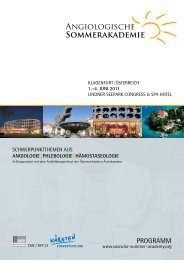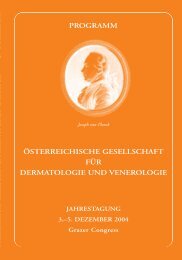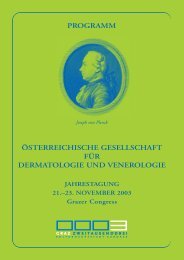PROGRAMM JAHRESTAGUNG 2012 30. Nov. – 2. Dez ... - ÖGDV
PROGRAMM JAHRESTAGUNG 2012 30. Nov. – 2. Dez ... - ÖGDV
PROGRAMM JAHRESTAGUNG 2012 30. Nov. – 2. Dez ... - ÖGDV
Sie wollen auch ein ePaper? Erhöhen Sie die Reichweite Ihrer Titel.
YUMPU macht aus Druck-PDFs automatisch weboptimierte ePaper, die Google liebt.
Poster Allergologie und Immunologie<br />
P 5<br />
Alterations in the regulatory T cell population in atopic dermatitis-like cutaneous<br />
inflammation in mice.<br />
Verena Martinz 1<br />
Christoph H. Tripp 1<br />
Daniela Finke 2<br />
Robert Gruber 1<br />
Christine Heufler-Tiefenthaler 1<br />
Matthias Schmuth 1<br />
Sandrine Dubrac 1<br />
1 Department of Dermatology and Venereology, Innsbruck Medical University,<br />
Innsbruck, Austria<br />
2 Developmental Immunology, Department of Biomedicine, University of Basel, Basel,<br />
Switzerland<br />
Although a role of abnormal immune reactivity in the multifactorial pathogenesis of<br />
atopic dermatitis (AD) is widely accepted, the complex immunological network leading<br />
to AD remains unclear. We characterized the regulatory T cell (Treg) population in AD<br />
patients and in two mouse models of AD exhibiting high epidermal TSLP expression;<br />
i.e., mice topically treated with vitamin D3 (VitD3) or those overexpressing TSLP under<br />
the K14 promotor. Adult patients with AD lesions showed elevated circulating Tregs as<br />
measured by demethylation of CpG dinucleotides in a conserved region of FoxP3 intron<br />
1. Similarly, mice from both mouse models exhibited higher percentages and numbers<br />
of ICOS-expressing CD4+ CD25+ FoxP3+ Tregs in skin draining lymph nodes (sdLN).<br />
Moreover, numbers of natural Tregs were increased. Direct upregulation of Tregs by<br />
VitD3 was excluded by removal of application site. Depletion of Langerin-expressing<br />
dendtitic cells (DC) indicated that other skin- and non-skin-derived DC can induce Tregs<br />
in our mouse models of AD. Furthermore, Tregs from VitD3-treated mice expressed<br />
increased levels of CTLA-4 and GARP and larger amounts of IL-10 and IL-13, if compared<br />
to K14-TSLP transgenic mice. Thus, although we observed increased numbers of<br />
activated Tregs, they are unable to counteract the ongoing skin Th2-inflammation. In<br />
addition, we showed that these Tregs can be induced by all DC subsets.<br />
44









